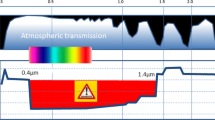Abstract
The mobile incoherent Doppler lidar (MIDL), which was jointly developed by State Key Laboratory of Severe Weather (LaSW) of the Chinese Academy of Meteorological Sciences (CAMS) and Ocean University of China, provided meteorological services during the Olympic sailing events in Qingdao in 2008. In this study, two experiments were performed based on these measurements. First, the capabilities of MIDL detection of sea-surface winds were investigated by comparing its radial velocities with those from a sea buoy. MIDL radial velocity was almost consistent with sea-buoy data; both reflected the changes in wind with time. However, the MIDL data was 0.5 m s−1 lower on average than the sea-buoy data due to differences in detection principle, sample volume, sample interval, spatial and temporal resolution. Second, the wind fields during the Olympic sailing events were calculated using a four-dimensional variation data assimilation (4DVAR) algorithm and were evaluated by comparing them with data from a sea buoy. The results show that the calculations made with the 4DVAR wind retrieval method are able to simulate the fine retrieval of sea-surface wind data—the retrieved wind fields were consistent with those of sea-buoy data. Overall, the correlation coefficient of wind direction was 0.93, and the correlation coefficient of wind speed was 0.70. The distribution of retrieval wind fields was consistent with that of MIDL radial velocity; the root-mean-square error between them had an average of only 1.52 m s−1.
Similar content being viewed by others
References
Dabas, A., J. Perin, and P. H. Flamant, 1997: Variational Analysis for Airborne Conically Scanned Doppler Lidar to Retrieve Mesoscale Wind Fields. J. Atmos. Oceanic Technol., 14, 1079–1090.
Darby, L. S., R. M. Banta, and R. A. Pielke, 2002: Comparisons between Mesoscale Model Terrain Sensitivity Studies and Doppler Lidar Measurements of the Sea Breeze at Monterey Bay. Mon. Wea. Rev., 130, 2813–2837.
Hu, H. W., and Q. Q. Hu, 2000: The scanning and inversion method of atmosphere wind by Doppler lidar. Applied Laser, 20(5), 213–215. (in Chinese)
Liao, M. X., 2003: Research on forecast of wind near sea surface. Periodical of Qingdao College of Pelagic Crew, 24(2), 6–10. (in Chinese)
Liu, Z. S., X. Q. Song, J. T. Liu, and K. L. Zhang, 2001: Incoherent pulse Doppler wind lidar. Chinese Science Bulletin, 46(24), 2080–2085. (in Chinese)
Mayor, S. D., and E. W. Eloranta, 2001: Twodimensional vector wind fields from volume imaging lidar data. J. Appl. Meteor., 40, 1331–1346.
Mu, R., L. P. Liu, X. Y. Xu, and W. Zhuang, 2007: The capability research on retrieving low-level wind field with 4D-VAR assimilation technique. Meteorological Monthly, 33(1), 11–18. (in Chinese)
Newsom, R. K., and R. M. Banta, 2004a: Assimilating coherent Doppler lidar measurements into a model of the atmospheric boundary layer. Part I: Algorithm development and sensitivity to measurement error. J. Atmos. Oceanic Technol., 21, 1328–1345.
Newsom, R. K., and R. M. Banta, 2004b: Assimilating coherent Doppler lidar measurements into a model of the atmospheric boundary layer. Part II: Sensitivity analyses. J. Atmos. Oceanic Technol., 21, 1809–1824.
Qiu, J. H., 1995: Two-wavelength lidar measurement of cloud-aerosol optical property. Adv. Atmos. Sci., 12(2), 177–186.
Qiu, J. H., 1999: Constraint inversion algorithm of lidar equation for deriving aerosol optical property. Adv. Atmos. Sci., 16(2), 216–228.
Reitebuch, O., C. Verner, I. Leike, P. Delville, P. H. Flamant, A. Cress, and D. Engelbart, 2001: Experimental validation of wind profiling performed by the airborne 10-μm heterodyne Doppler lidar WIND. J. Atmos. Oceanic Technol., 18, 1331–1344.
Sheng, C. Y., J. L. Wang, and X. G. Diao, 2007: The features and three-dimensional structures of sea and land breeze during the Qingdao 2006 International Regatta. Periodical of Ocean University of China, 37(4), 609–614. (in Chinese)
Sun, J., D. Flicher, and D. Lilly, 1991: Recovery of threedimensional wind and temperature fields from single-Doppler radar data. J. Atmos. Sci., 38, 876–890.
Sun, J., and N. A. Crook, 1994: Wind and thermodynamic retrieval from single-Doppler measurements of a gust front observed during Phoenix II. Mon. Wea. Rev., 122, 1075–1091.
Wang, B. X., D. S. Sun, and Z. Q. Zhong, 2007: Analysis of data processing method for Doppler wind lidar. Infrared and Laser Engineering, 36(3), 373–376. (in Chinese)
Xiao, Y. J., and L. P. Liu, 2006: Study of methods for interpolating data from weather radar network to 3-D grid and mosaics. Acta Meteorologica Sinica, 64(5), 647–657. (in Chinese)
Xu, X. Y., G. G. Zheng, and L. P. Liu, 2004: Dynamical and microphysical retrieval from simulated Doppler radar observations using the 4DVAR assimilation technique. Acta Meteorological Sinica, 62(4), 410–422. (in Chinese)
Author information
Authors and Affiliations
Corresponding author
Rights and permissions
About this article
Cite this article
Wang, G., Liu, L., Liu, Z. et al. The application of sea-surface wind detection with doppler lidar in Olympic sailing. Adv. Atmos. Sci. 28, 1471–1480 (2011). https://doi.org/10.1007/s00376-011-9189-5
Received:
Revised:
Published:
Issue Date:
DOI: https://doi.org/10.1007/s00376-011-9189-5




